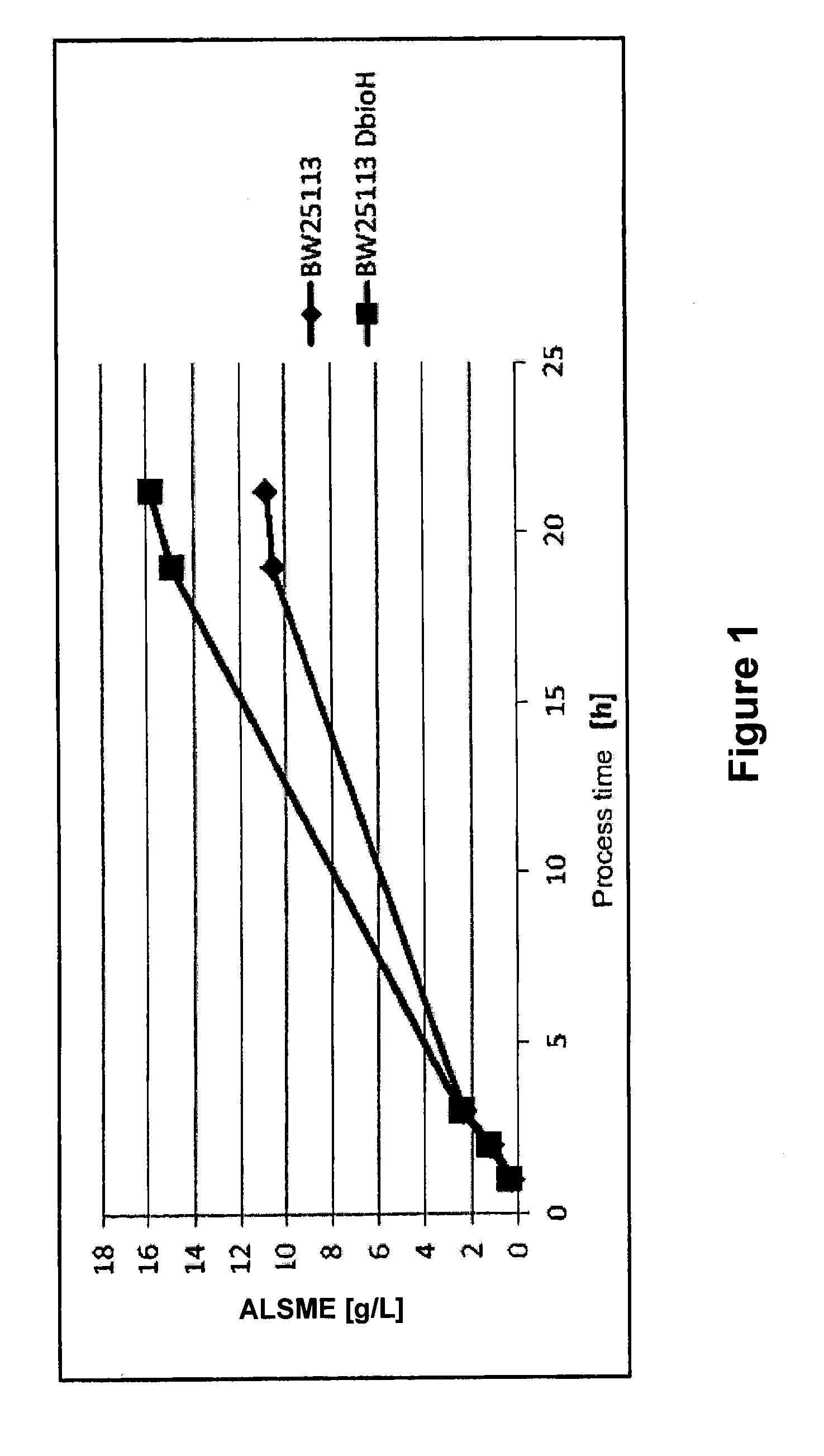Process for reacting a carboxylic acid ester
- Summary
- Abstract
- Description
- Claims
- Application Information
AI Technical Summary
Benefits of technology
Problems solved by technology
Method used
Image
Examples
example 1
[0098]Inactivation of bioH in E. coli W3110 and BW25113
[0099]A new plasmid was needed to specifically knock out the bioH gene (b3412, SEQ ID NO:1) using the basis vector pKO3_E933. This was based on the pKO3_E933 vector (SEQ ID NO: 14), with 500 by being inserted upstream (SEQ ID NO: 3) and 500 by being inserted downstream of the bioH gene (SEQ ID NO: 4), separated by a PspXI cleavage site (CCTCGAGG). The finished plasmid was internally referred to as AHp-LL-42 (SEQ ID NO: 5). To finish, the following oligonucleotides were used:
o-LL-314,SEQ ID NO: 65′-CCGGGGATCGCGGCCCGGCTTCGCTATCCCATTGGCAGT-3′o-LL-315,SEQ ID NO: 75′-CCTCTGCTTCAACGCCCTCGAGGCATCCGCTATTGTTCTCTTTTGACTTACAAGGATG-3′o-LL-316,SEQ ID NO: 85′-GCGTTGAAGCAGAGGGTGTAGGTG-3′o-LL-317,SEQ ID NO: 95′-TAGAGGATCGCGGCCCAAACTGGCAAGGCAGCTTTATGC-3′
[0100]The 500 bp regions were provided using the above primers from available chromosomal DNA of E. coli W3110 by means of polymerase chain reaction (PCR), with o-LL-314+o-LL-315 were used for th...
example 2
[0110]Production of methyl amino-dodecanoate by E. coli W3110 Containing a Deletion in the bioH Gene by Employing Expression Vectors for the Genes Bacillus subtilis ald and Chromobacterium violaceum Cv—2025 in Combination with an Expression Vector for the alkB, alkG, alkT and alkL Genes of the Pseudomonas putida alk Operon.
[0111]The E. coli strains containing expression vectors for the genes Bacillus subtilis ald (coding for an alanine dehydrogenase, codon-optimized for E. coli), Chromobacterium violaceum Cv—2025 (coding for a transaminase, codon-optimized for E. coli) in combination with an expression vector for the alkB, alkG, alkT (coding for an alkane monooxygenase, a rubredoxin and a rubredoxin reductase) and alkL (coding for a membrane / transport protein) genes of the Pseudomonas putida alk operon were generated by preparing electro-competent E. coli W3110 ΔbioH cells and the corresponding E. coli W3110 control strain. This was carried out in a manner known to the skilled worke...
example 3
[0131]Production of methyl amino-dodecanoate by an E. coli Strain Having a Deletion in the bioH Gene by Employing an Expression Vector for the Genes Bacillus subtilis ald and Chromobacterium violaceum Cv—2025 and the alkB, alkG, alkT and alkL Genes of the Pseudomonas putida alk Operon
[0132]The E. coli strains containing an expression vector for the genes Bacillus subtilis ald (coding for an alanine dehydrogenase, codon-optimized for E. coli), Chromobacterium violaceum Cv—2025 (coding for a transaminase, codon-optimized for C. tropicalis), alkB, alkG, alkT (coding for an alkane monooxygenase, a rubredoxin and a rubredoxin reductase) and alkL (coding for a membrane / transport protein) of the Pseudomonas putida alk operon were generated by preparing electro-competent E. coli BW25113 ΔbioH cells and the corresponding E. coli BW25113 control strain. This took place in a manner known to the skilled worker. The strains are from the commercially available Keio collection. They were transform...
PUM
| Property | Measurement | Unit |
|---|---|---|
| Acidity | aaaaa | aaaaa |
| Hydrophobicity | aaaaa | aaaaa |
Abstract
Description
Claims
Application Information
 Login to View More
Login to View More - R&D
- Intellectual Property
- Life Sciences
- Materials
- Tech Scout
- Unparalleled Data Quality
- Higher Quality Content
- 60% Fewer Hallucinations
Browse by: Latest US Patents, China's latest patents, Technical Efficacy Thesaurus, Application Domain, Technology Topic, Popular Technical Reports.
© 2025 PatSnap. All rights reserved.Legal|Privacy policy|Modern Slavery Act Transparency Statement|Sitemap|About US| Contact US: help@patsnap.com

